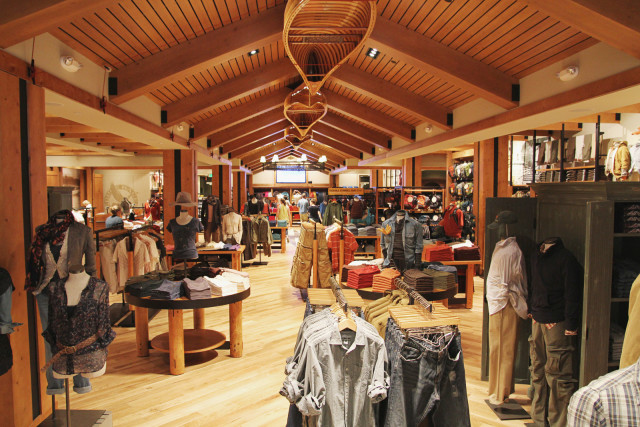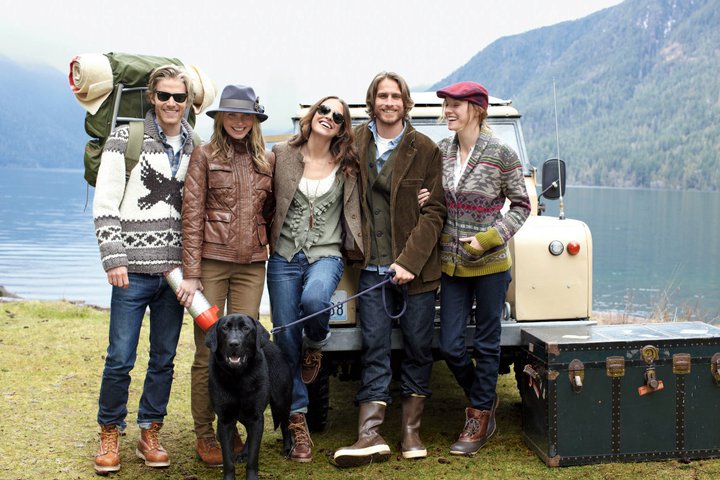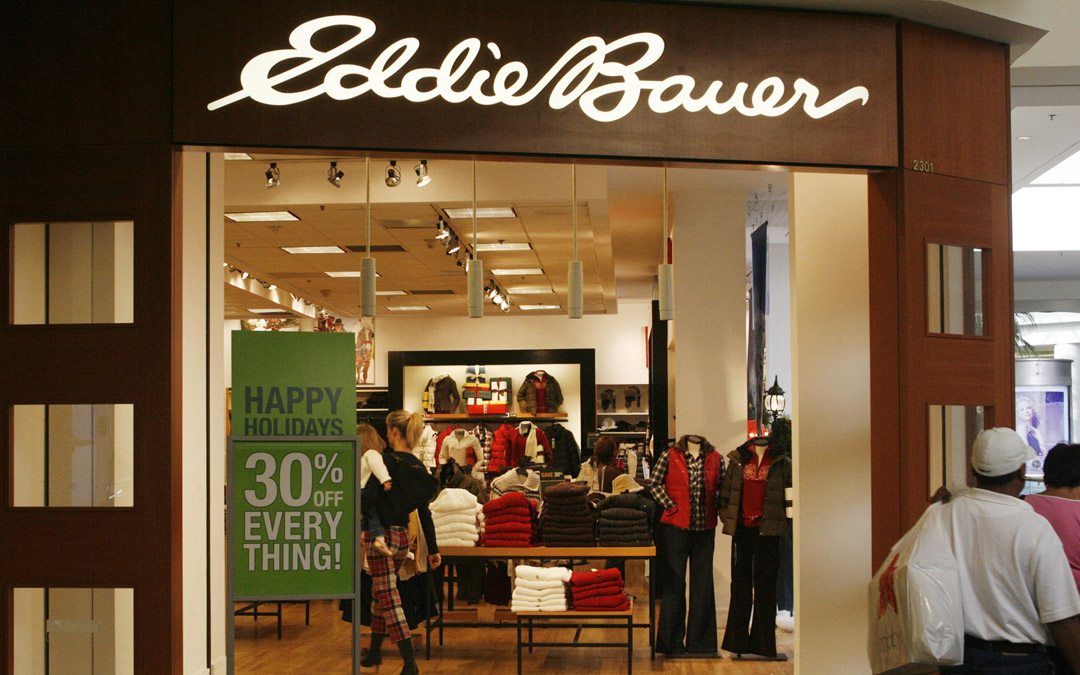Eddie Bauer Holdings, Inc. (EBH) is an American holding company, headquartered in Bellevue, Washington, which operates the Eddie Bauer clothing store chain. EBH was formed after Eddie Bauer’s former parent company, Spiegel, Inc., went bankrupt in 2003. Eddie Bauer currently operates three independent sales channels:
Retail stores – sells “premium” merchandise
Outlet stores – sells merchandise and inventory overstocks at lower prices
Direct order center – sells merchandise through call centers in Groveport, Ohio, and the company’s website.
The company was established in 1920 in Seattle by Pacific Northwest outdoorsman, Eddie Bauer (1899 – 1986). In 1940 Bauer patented the first quilted down jacket. He later patented numerous other designs. The company was the first independent company which the United States Army hired and allowed to use a logo on the Army-issued uniform.
Bauer retired and sold the company in 1968. General Mills bought the company in 1971; in 1988, Spiegel bought it from General Mills. In 2003, Spiegel, Inc., entered bankruptcy. The Spiegel catalog and all other assets were sold, except for Eddie Bauer. In May 2005, Spiegel, Inc., emerged from bankruptcy under the name “Eddie Bauer Holdings” and is owned primarily by Golden Gate Capital. In addition to the three sales channels the company operates a distribution and fulfillment center in Groveport, Ohio; an IT facility in Westmont, Illinois; and a distribution center in Vaughan, Ontario. Eddie Bauer is also a minority participant in joint venture operations in Japan and Germany that include retail stores, catalogs, and websites. The company also selectively licenses the Eddie Bauer brand name and logo for various products sold through other companies including eyewear, furniture, bicycles, and, up until the 2010 model year, upper level versions of Ford Motor Company’s Bronco, Explorer, Expedition and Excursion SUVs.
Eddie Bauer’s flagship store is in Bellevue’s Bellevue Square mall. A Midwest Flagship opened in August 2010 at Easton Town Center in Columbus, Ohio.
Eddie Bauer Holdings, Inc., filed for Chapter 11 bankruptcy protection in Delaware on June 17, 2009.



History
1920–1949: Eddie Bauer’s Sport Shop
In 1920, Eddie Bauer, at the age of 21, established his first store in downtown Seattle. “Eddie Bauer’s Tennis Shop” opened in the back of a local hunting and fishing store. He first specialized in building and repairing tennis rackets and the shop was only open during the tennis season; Bauer spent the rest of the year pursuing his own sportsman activities. Eventually Bauer expanded his line of merchandise to include his own hand-made golf clubs and fishing tackle and he changed the name of his store to “Eddie Bauer’s Sport Shop.” Bauer would go on to develop and patent a standardized shuttlecock. The Bauer Shuttlecock popularized badminton in the United States. While operating this first store, Bauer developed his creed, “To give you such outstanding quality, value, service and guarantee that we may be worthy of your high esteem”, still used by the modern company
The Skyliner
While on a winter fishing trip in Washington, Eddie Bauer developed hypothermia. After this he began trying to develop alternatives to heavy wool garments used by outdoorsmen at the time. He attempted to offset the bulkiness of down by quilting a down-filled jacket. In 1940, Bauer then patented the first quilted goose down-insulated jacket in the United States: U.S. Design Patent 119,122 and introduced it in his store as “The Skyliner”. Bauer took out more than 20 patents on various outdoor clothing and sporting equipment between 1934 and 1937.
U.S. Army Air Corps commission
In 1942, the United States Army Air Corps commissioned Eddie Bauer to develop the B-9 Flight Parka. More than 50,000 parkas were manufactured for World War II airmen.[9] The parka was designed to keep pilots warm at high altitudes. Of all government suppliers, Eddie Bauer alone was granted permission to affix his company logo to his products used by the army.In addition to the parkas, Eddie Bauer supplied the army with backpacks, pants and sleeping bags, all of which became standard issue for American troops in the war. Prior to his involvement the army had a shortage in sleeping bags; Bauer eventually sold over 100,000 sleeping bags to the armed services.
Mail-Order catalog
In 1945, soon after he began selling women’s clothing as well as men’s, Eddie Bauer issued his first mail-order catalog. The original mailing list included the names of 14,000 soldiers who had worn Eddie Bauer clothing provided by the army during their service.[8] By 1949, Bauer was employing 125 seamstresses. He eventually closed his downtown store and got out of retailing, except for showroom sales at his Seattle factory.[7]
1950–1959: William F. Niemi Partnership
By 1950, Eddie Bauer’s health was declining due to overwork and a serious back injury. He took on local businessman and his hunting partner, William F. Niemi. Bauer transferred all of the common stock in Eddie Bauer, Inc., to Niemi who reorganized the store and improved cash flow. It was with Niemi that Bauer decided to focus his efforts on the mail order catalog. By 1953, catalog sales totaled US$50,000. At this point, Bauer returned to being a shareholder in the company and formed a fifty-fifty partnership with Niemi.[8][10] Throughout the 1950s, Eddie Bauer, Inc., outfitted various scientific and exploratory expeditions.
Jim Whittaker
In 1960, Eddie Bauer and William Niemi took on their sons, Eddie C. Bauer and William Niemi Jr. as partners in the company. Eddie Bauer went on to supply his equipment for the American K2 Himalayan Expedition and several journeys through Antarctica. In 1963, James W. Whittaker, the first American to climb Mount Everest, was wearing an Eddie Bauer parka. He wore Bauer’s products during his whole expedition.[8]
Eddie Bauer sells Eddie Bauer
In 1968, Eddie Bauer retired and he and his son sold their half of the business to William Niemi and his son for $1.5 million. A group of investors who had helped finance the buyout gained stock in the company. That same year the first store outside of Seattle opened, in San Francisco. In 1970, their first large store opened in downtown Seattle. In order to appeal to a broader range of consumers, Niemi shifted the company’s focus featuring casual lifestyle apparel. The emphasis on women’s apparel and accessories was greatly expanded in all stores, as well.
1971–1987: General Mills and Ford Eddie Bauer Branding
In 1971, William Niemi sold the company to General Mills. After the sale, the company shifted its focus to casual clothing and expanded to 61 stores and made $250 million in sales by 1988.[9] This shift included the company dropping the tagline “Expedition Outfitter.”[13] In 1987, Eddie Bauer introduced the “All Week Long” concept. This was meant to provide women with clothing they could wear throughout the week (e.g., at work) as opposed to just weekend wear. This concept was sold solely through the catalog when the first All Week Long store opened in Portland, Oregon, in the summer of 1991.
Eddie Bauer also began a cross-branding partnership with Ford Motor Company in 1983 to produce Eddie Bauer Edition Ford vehicles. In 1984, the first Eddie Bauer Edition Ford debuted: the limited edition “Eddie Bauer Bronco.” Eddie Bauer was a popular style in Ford cars.
Here is a list of vehicles available with Eddie Bauer style:
Ford Bronco (1984-1996)
Ford Explorer (1991-2010)
Ford Expedition (1997-2010)
Ford F-150 (1994-1996)
Ford Excursion (2003-2005)
Ford Taurus X (2008)
Ford Aerostar (1988-1994)
1988–2005: Spiegel, Inc.
Spiegel catalog purchased Eddie Bauer from General Mills in 1988. Aggressive expansion continued and within the first year the company had expanded from 60 to 99 stores. By 1996, an additional 300 stores had been opened.
In 1991, Eddie Bauer launched Eddie Bauer Home, a collection of home furnishings, including furniture, tableware, decor items and linens. The collection was meant to appeal to the customers that purchased apparel from the company. The home store maintained a “warm and cozy” theme by presenting beds with thick blankets and floors covered with wool rugs.
An Eddie Bauer store in Kobe, Hyōgo, Japan
In 1996, Eddie Bauer launched its Web site, www.eddiebauer.com, establishing a third channel of distribution to complement the retail and catalog divisions. The company launched EBTEK, a new product line, including both the EBTEK System of high-performance interlocking outerwear, and EBTEK casual activewear. The EBTEK System includes fabrics such as Gore-Tex, Polartec 200, and Eddie Bauer Premium Goose Down. Eight new stores opened in Japan that year, bringing the total to 14 stores and three outlets. Eddie Bauer Germany also opened two new stores in Germany.
Eddie Bauer continued to expand in North America and internationally throughout 1997, opening the 500th U.S. store. Internationally, Eddie Bauer Japan opened 11 new stores, bringing the total to 24 stores in Japan, along with four outlet stores in various locations. In 1997, Eddie Bauer Germany opened five new stores, bringing the total to seven Eddie Bauer stores in Germany. Eddie Bauer enters into a licensing agreement with the Lane Company, offering an exclusive collection of Eddie Bauer Home by Lane furniture.
Eddie Bauer Apparel Store in Boulder, Colorado
By 1998, over 500 stores had been opened in North America (556), Japan (32), and Germany (9). Eddie Bauer entered into a three-year licensing agreement with Giant Bicycle, Inc., to launch a line of Eddie Bauer Edition mountain bikes for off-terrain and city riding. Eddie Bauer and Signature Eyewear joined to produce the Eddie Bauer Eyewear collection for men and women. Additionally, Eddie Bauer and Cosco, Inc., joined to build upon Eddie Bauer’s “Baby by Eddie Bauer” collection of Eddie Bauer Home merchandise for infants.
In 1999, Safeco Field, the new home of the Seattle Mariners, signed a two-year sponsorship agreement with Eddie Bauer, establishing Eddie Bauer as the official apparel sponsor of Safeco Field event staff through the 2000 season.
Also in 1999, Eddie Bauer presented American Forests with a check for $2.5 million, representing the 2.5 million trees planted nationally through Eddie Bauer’s “Add a Dollar, Plant a Tree” retail program.[citation needed] Eddie Bauer’s 100th birthday is celebrated with the culmination of national “Building Cities of Green” tree planting tour, in Seattle, Washington.[citation needed] On October 19, Eddie Bauer retail stores distribute one-half million trees to customers in honor of company founder. The one-millionth Eddie Bauer Edition Ford rolled off the assembly line.
In 2000, Signature Eyewear launched Eddie Bauer performance sunwear featuring Oakley XYZ Optics. National Geographic Ventures joined forces with Eddie Bauer to include the corporate sponsorship of a new giant screen film on Lewis & Clark.Other elements included a multi-tiered travel alliance and Eddie Bauer sponsorships of Radio Expeditions (a National Geographic and National Public Radio co-production) and the National Geography Bee. Eddie Bauer opened a store in Honolulu, Hawaii, completing Eddie Bauer’s entry into all 50 American states.
Also in 2000, Eddie Bauer launched its first exclusively on-line business venture, eddiebauerkids.com. Eddie Bauer joined forces with American Forests to launch the Wildfire ReLeaf program, established to help in the restoration of land decimated by forest fires in 2000.
In 2001, Eddie Bauer teamed with American Recreation Products through a licensing agreement to launch a collection of camping equipment. Eddie Bauer was awarded the Hispanic College Fund Corporation of the Year award.[citation needed] The NAACP, Washington, D.C. Urban League, and the Seattle Urban League awarded Eddie Bauer with Corporate Sponsorship Awards.[citation needed] Eddie Bauer launched the first annual Add a Dollar to Your Local Community Charity program during the Eddie Bauer Associate Giving Campaign, and each of the 550-plus Eddie Bauer stores selected their own local charity to donate the funds raised in their local store. Eddie Bauer associates and customers raised nearly $1,000,000 for the victims of 9/11.
Two years later Spiegel filed for bankruptcy. It sold its flagship catalog business and its Newport News women’s apparel unit and announced that Eddie Bauer Inc. also was for sale. Meanwhile, more than 200 Eddie Bauer stores were closed. The company’s corporate headquarters, in Redmond, Washington, was sold to the Microsoft Corporation.
June 2009
On June 17, 2009, Eddie Bauer filed for Chapter 11 bankruptcy protection. The company said it planned to sell itself for $202 million to CCMP Capital Advisors, a private equity firm. Bank of America, GE Capital and the CIT Group have agreed to provide up to $100 million in financing during the bankruptcy case. The sale to CCMP will proceed through what is known as a 363 sale process in bankruptcy court. A judge would need to approve the sale, and other potential bidders could emerge. CCMP, as a so-called stalking horse bidder, is entitled to a $5 million breakup fee if it loses during the court-supervised auction process. “We’re not looking to liquidate the company or close most of the stores”, said Jonathan Lynch, a CCMP managing director, as quoted in The New York Times report. The report continued: “CCMP first took a look at Eddie Bauer in 2004, but was dissuaded from making an investment because the company was then focused on becoming a women’s casual apparel chain, along the lines of J. Jill or Talbots. … A new management team led by Fiske began returning the company … toward its outdoor adventure roots” and led to the renewed contacts with CCMP.[23] The company was acquired at bankruptcy auction by Golden Gate Capital in July 2009.
May 2013
In May 2013, Eddie Bauer joined with Disney, Nike, Patagonia, Quiksilver, and Todd Oldham to be the first apparel brands to join the Otis Sustainability Alliance. This is a partnership between the fashion industry and higher education that aims to advance environmental, social and economic sustainability.
May 2013-Present
According to Women’s Wear Daily, in 2014, Joseph A. Bank Clothiers, Inc. “have been in talks about an acquisition” with Eddie Bauer and, in February 2014, announced that “it will acquire Eddie Bauer in a cash-and-stock deal valued at $825 million.”In March 2014, it was announced that Men’s Wearhouse would buy out Jos. A. Bank and that Jos. A. Bank would not acquire Eddie Bauer.
Brandzaar Comments:
Eddit Bauer is a strong brand in the North American market, but it’s only been able to expand into the Japanese market. Brandzaar believes with the right positioning it could do well in the Chinese market especially given the amount heritage the marketing department has to draw on.

Type: Private
Industry: Retail
Founded: Seattle, Washington, U.S. (1920)
Founder: Eddie Bauer
Headquarters: Bellevue, Washington, U.S.
Number of locations: 370
Area served: United States, Canada, Japan, Germany
Key people: Michael Egeck(President, CEO), William End(Board Chair)
Products: Clothing, sportswear, outdoor gear
Owner: Golden Gate Capital
Number of employees: 10,000 worldwide (2007)
Website: http://eddiebauer.com/ http://firstascent.com/

